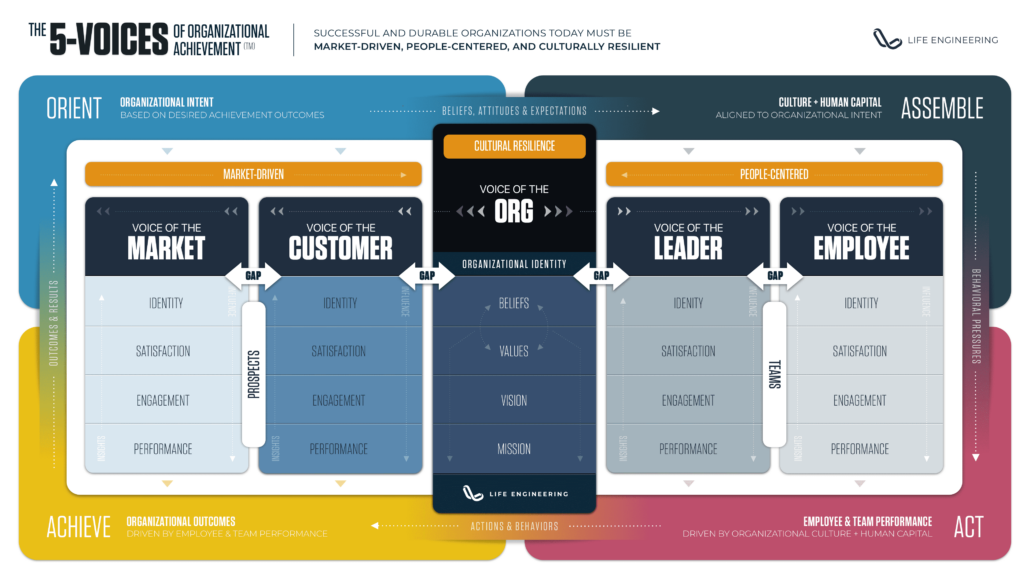The
Five Voices
Managing Energy Within and Without
academy
In any organization, there are five voices. They are the voices of the market, the customer, the organization, the leader, and the employee. By focusing on the interplay between these voices, rather than listening to only one voice at a time, organizations will see increased engagement, satisfaction, and performance.
The Five Voices is a simple way of looking at how to relate to stakeholders in any organization. The missing link, however, is what goes on between the five voices. For an organization to operate at peak effectiveness, it must find a way to balance these voices to be both market-driven and people-driven and centered.
Lesson 1
INTRODUCTION
course objectives
- Classify and understand each of the Five Voices in your organization
- Apply the Five Voices model to understanding both the “within the voice” and “between the voices” engagement opportunities
- Examine and question where the “gaps” and “synergies” are both within and between voices
- Evaluate what changes need to be made “within” and “between” voices to increase engagement in the organization
- Construct improved ways to integrate the five voices into organizational culture and decision making
Creating a Chorus of Engagement
Leaders, like conductors, have been given the responsibility to direct their respective teams. But too often the various players start out in disharmony and retreat to their silos to do their own work.
The organizational leader as conductor must then bring the musicians back together and harmonize the disparate parts into a single, cohesive whole.
The Five Voices – An Overview
In any organization, there are five voices. They are the voices of the market, the customer, the organization, the leader, and the employee. By focusing on the interplay between these voices, rather than listening to only one voice at a time, organizations will see increased engagement, satisfaction, and performance.
Lesson 2
What are the 5 Voices?
Getting Everyone on the Same Page
Decisions are seldom simple, particularly when they involve multiple stakeholders with differing backstories, interests, and voices. Wise leaders learn to orient their teams away from the “silo effect” and raise a voice in the decisions that impact them.
Whose are the 5 Voices, and What Do They Want?
Each of the five voices contributes important and unique input to the organization. Together, these five voices shape organizations, their prospects, and teams. Whether these voices blend into harmony or disruptively clash is in the hands of the organizational leader.
Lesson 3
A Common Disconnect
Building for “Within,” Striving for “Between”
We can draw a straight line between what we experience, how that drives what we do, and the results we end up getting.
Your responsibility as a leader is to understand how to create the processes that drive the customer experience, integrate them into a new environment, and then deliver the right results.
Voices from Outside
Leaders have the responsibility to be equally attentive to both market and customer voices. Doing so encourages innovation and creativity as organizations find solutions to problems that are beneficial to both groups.
Voices from Inside
A disconnect between the voice of leadership and the voice of teams can lead to disengaged employees. Do you know what your employees and customers really want?
Lesson 4
Crafting Connections
The Role of Culture in Connection
If you don’t interact with the things around you, eventually you won’t notice them anymore. Find an engaging cultural voice that pulls employees and leaders (inside voices) and customers and markets (outside voices) together.
The Cognitive Basics of See / Do / Get
We can draw a straight line between what we experience, how that drives what we do, and the results we end up getting. Your responsibility as a leader is to understand how to create the processes that drive the customer experience, integrate them into a new environment, and then deliver the right results.
Lesson 5
Getting the Right Results
Does Anyone Want This?
Challenging yourself and your ideas against the needs of customers and markets before you move to assemble a team and act on that idea is critical.
Assembling Teams to Respond to Prospects
A common challenge leaders face is helping their teams be maximally responsive to the voice of customers and markets. What new approaches can you try in your organization to assemble teams that are innovative and effective?
Bringing Opportunities to Markets and Customers
There is power in redefining how teams act in their various roles and responsibilities, while meaningfully connecting them with customers and markets. Does your organization have a culture founded on the premise that “every employee can contribute”?
Meaningful and Measurable Results
It is possible to make a positive impact despite negative situations. How we purposefully go about designing meaningful connections to each other is vital. At the heart of every organization are its people and customers.
Lesson 6
Conclusion
Orchestrating the Five Voices
As organizations orchestrate the five voices, listening to and understanding each other instead of competing to be heard, engagement will increase and your leaders and employees will be able to respond with products, services, and solutions that matter to customers and the market.
We care deeply about helping you live your best life.
So much so, that I want to give you a free copy of my most recent book, Spiritual Resonance, to help you fully discover yourself and live authentically.
We’ve also created an assessment to help you discover your Identity, and have trained AI to understand and talk to you about your specific results!





Responses